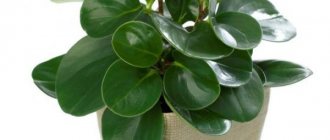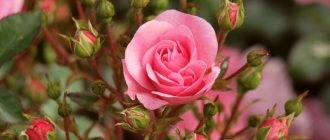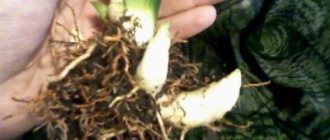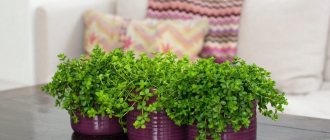Indoor floriculture today is not just a tribute to fashion, but an interesting and useful hobby that relieves the blues and depression, allowing you to show your creativity and make your home cozy and unique. Sometimes one small plant is enough to not feel lonely, because it is alive, it needs to be looked after, and in order for it to be healthy and beautiful, this must be done correctly. Peperomia will not take up much space in the house and will not cause much trouble, but if simple conditions are met, it will delight you with its lush outfit for many years. What should a gardener know to avoid problems when growing at home?
Geography of habitat, description of appearance and photo
Peperomia Rosso is native to the tropics of America and Asia. Prefers shaded spaces. Often found in forests. Grows on trees, snags, and peaty soils. Less often - on rocks on a moss floor.
Peperomia Rosso is a shrub about 25 cm high. Its leaves are large and long. They are located close to each other and grow in bunches. The upper part of the leaves is dark green in color, and the lower part is red-burgundy.
Below you can see a photo of the plant:
About the plant
Peperomia Rosso belongs to the Pepper family and the genus Peperomia. A more accurate name is Peperomia Caperata "Rosso". The flower is an epiphyte, and therefore grows in nature on other plants. It usually blooms in spring and summer, during which peduncles with spikes of inflorescences rise above the leaves. Fruits with small dryish berries.
The name Peperomia takes its roots from two Greek words: “peperi” - pepper, “omos” - identical, and therefore you can often hear that people call it “pepper-like”. Because of the shape of the flowers, it has another nickname - “rat tail plant.” Latin name - PEPEROMIA CAPERATA "ROSSO".
Most species of the genus Peperomia originate in the tropical forests of South America, as well as Asia. The plant is not tall, but it compensates for this with very bright leaf colors. The leaves are elongated, dark green on one side, bright purple on the other. Their arrangement makes Peperomia look like a star. Rosso is distinguished from other varieties of this species by its pointed and elongated leaf shape. During rare flowering, it pleases the owner with thick and long flowers. Peperomia grows in the humid tropics and subtropics of South America.
Home care
Peperomia Rosso is an unpretentious plant. But, since the natural habitat of this flower is the tropics, caring for it requires some special features.
Temperature
Optimal temperature conditions for growing Peperomia Rosso:
- in spring and summer - from 20 to 22°C;
- in autumn and winter - from 18 to 22°C.
The soil temperature should not fall below 17°C.
Important! Peperomia Rosso is afraid of drafts. Therefore, it is not recommended to take it outside the premises.
Watering
Like all tropical representatives of the flora, Peperomia Rosso loves moisture. The flower needs intensive watering in spring and summer. At other times of the year, it is recommended to reduce the frequency of soil moisture.
Before watering, the water must first be settled. Its temperature should be slightly higher than the ambient temperature (approximately 2 degrees).
Fleshy leaves are able to independently provide themselves with moisture reserves. But if the specimen has delicate foliage and a thin stem, dry air can harm it. Therefore, you should take care of additional hydration by placing containers of water nearby. On hot days it is recommended to spray the plant.
Overwatering can cause leaves to turn black and sometimes cause them to fall off. In this case, it is recommended to stop watering for a week, allowing the soil to dry out.
Light
Since in nature Peperomia Rosso grows in areas shaded from the sun, it is necessary to provide the plant with dim, diffused lighting. The best option is considered to be window sills located in the western and eastern parts of the house.
Priming
Attention! Light and loose soil is considered the most suitable for peperomia. Air permeability of the soil is important for this plant.
Optimal soil composition:
- leaf soil (2 parts);
- peat (1 part);
- coarse sand or perlite (2 parts).
Be sure to use drainage as the bottom layer.
Trimming
Peperomia Rosso does not require pruning, but to preserve the decorative appearance of the flower, it is recommended to remove dry leaves. The procedure consists of the following steps:
- Inspect the plant for dried areas.
- Remove marked leaves and shoots using garden shears.
It is recommended to prune starting from the top of the plant.
Feeding
In winter, peperomia does not need feeding. During other seasons, complex fertilizers are used once every 2-3 weeks.
Pot
Peperomia Rosso prefers tight spaces, so you should choose a small pot. If you plant it in a container that is too large, the flower may slow down the growth of its above-ground part.
For each transplant, it is recommended to use a container 2 cm larger in diameter than the previous one.
Transfer
Reference. In the first 3 years, the flower should be replanted annually in the spring. If it was purchased in winter, it is recommended to postpone the procedure to March. In the future, one transplant every 2-3 years is sufficient.
Procedure:
- Pour drainage into the pot. The optimal layer thickness is 2 cm.
- Fill the container with soil, leaving some free space.
- Carefully remove the plant with a lump of earth from the pot.
- Place the flower in a new container and add soil.
- Water the soil.
- Fill the remaining free space with soil.
It is forbidden to compact the soil by pressing it down. There is a danger of damaging the delicate roots of the flower.
Wintering
In winter, spraying the plant is not recommended. Given the short day, a source of additional lighting should be used. It is very important to control the soil temperature in winter. For insulation, you can lay a felt napkin under the pot. Fertilizing should be excluded or used no more than once every 6 weeks.
Growing problems
Almost all problems that arise when growing peperomia at home arise from improper care. For example, hypothermia and excessive watering lead to the creation of conditions favorable for the development of pathogenic microflora and the proliferation of pests on weakened bushes.
With careful attention, you can immediately notice the symptoms of diseases and other factors that depress it. They are manifested by the appearance of cobwebs, rotten or dry areas, black spots on leaves, etc.
Dark spots are a sign of plant disease
- If pests, which include nematodes, thrips, mealybugs and spider mites, have appeared recently, they are removed manually, collecting them from the underside of the leaves;
Mealybug on a house plant
- Serious pest attacks are repelled with the help of insecticides or folk remedies - tobacco infusion, laundry soap solution.
Advice. Use folk remedies from time to time to prevent pests.
- To get rid of fungal diseases, fungicidal drugs are used. But this is not enough, you also need to adjust the care of the plant: reduce watering, ensure normal temperature and lighting.
Advice. During treatment, the diseased plant must be quarantined in a place isolated from other flowers.
If no pests or diseases are found, but the peperomia is withering away, you can guess its needs by the state of its leaves:
- The edges began to dry out and turn brown - the plant is cold;
Brown leaf edges are a sign of insufficient air temperature for peperomia
- The leaves have begun to fall - you need to increase watering;
- Spots of rot have appeared on them - watering should be reduced or temporarily stopped, since the soil is waterlogged;
- The leaves wither and wrinkle - the plant suffers from excess light.
Reproduction
Peperomia Rosso is propagated by cuttings, bushes and seeds.
Propagation by cuttings:
- Leave a small cutting on the leaf (about 2-4 cm).
- Place it in damp moss. You can use sand.
- After roots have formed (on average after 3 weeks), plant the plant in a pot.
Seed method:
- Fill the container with substrate: sand and leaf soil. Moisturize.
- Sow the seeds.
- Cover the container with glass.
- Ventilate and spray the seedlings 2-3 times a week.
- After sprouts appear and 2 leaves form, transplant the seedlings into another container in increments of 2-3 cm.
- After strengthening and rooting, young plants should be transplanted into separate pots with a diameter of 7 cm.
Bush division:
- Remove the flower from the pot.
- Examine the root and carefully divide it into 2 equal parts.
- Plant the resulting bushes in separate pots.
- Moisten the soil generously.
Important! It is not recommended to use scissors or other tools to divide the bush. The procedure must be performed manually.
What to look for when purchasing
Just knowing how to care for a peperomia after purchase is not enough. When choosing a specimen in a flower shop, pay attention to three nuances.
- Foliage color. The selected plant should have a rich, maximally bright leaf color. It would be good if there were patterns on the leaves. A patterned subshrub looks even more interesting in the interior.
- Stem quality. Visually, the stem should be healthy. Any damage to the shoots is a wake-up call to abandon the selected specimen.
- No root rot. Gray moss at the base of the root is a clear sign of a rotting root system. There is no need for a sick plant in the house, given the risk of the disease spreading to other indoor flowers.
Peperomia is not only beautiful, but also smart. Scientists have proven that the phytoncides secreted by the plant destroy the pathogenic bacteria of staphylococcus and streptococcus contained in the air by 50-70%.
Diseases and pests
Most peperomia Rosso diseases occur as a result of violation of the rules of care:
- Lack of moisture and low temperatures can cause leaves to fall.
- Drafts are dangerous due to the appearance of brown spots.
- Watering too much can cause the flower to rot.
The following types of parasites are dangerous for Peperomia Rosso:
- mites;
- scale insects;
- nematodes;
- mealyworms.
Enemies among insects
Those who know how to care for peperomia and apply the rules of care in practice should not be afraid of attacks from pests. But it is still necessary to know about possible enemies. The following table will help you understand the symptoms and treatment.
Table - Peperomia pests and methods of controlling them
| Pest | Reason for appearance | Symptoms of the lesion | Treatment options |
| Mealybug | — Draft; — waterlogging of the soil; - low air temperature | - Formation of a white fluffy mass in the leaf axils | — Treatment with a cotton swab dipped in an alcohol solution; - treatment with insecticides |
| Thrips | — Heat in the room; — critically low humidity | — The appearance of tiny light spots on the leaf plate | — Treatment with insecticides |
| Spider mite | — Dry air; - heat | - The appearance of cobwebs between leaf plates | — Warm shower; - spraying with insecticides |
| Nematodes | — Infection from a neighboring plant | — Treatment with insecticides; - daily irradiation with a quartz lamp (3 minutes) for prevention | — Dying of large sections of the leaf; - leaves turn black and fall off; - formation of spherical growths on stems |
| Shchitovka | — Dry air | — Formation of small brown growths on the stems | — Treatment with insecticides |
If gray rot is found on the root fragment of peperomia, the plant is unlikely to be saved. The primary task after diagnosing the disease is to isolate the diseased flower from other inhabitants of the windowsill. Most likely, the plant will have to be thrown away and the pot and tray will have to be boiled to prevent the spread of rot.
Insecticides are chemical preparations whose action is aimed at destroying insect pests.
Similar flowers
There are 5 types of peperomia, which are similar to Rosso, but have different shades:
- Peperomia Watermelon. The leaves are colored green and red, characteristic of watermelon.
- Peperomia Marble is distinguished by the presence of burgundy rims and veins on the leaves.
- Tricolor has foliage with a white border.
- Peperomia Wrinkled is distinguished by its bright colors and glossy leaf surface.
- Caperata Lilian has a unique shape - its flowers look like lilies.
Peperomia Rosso is a beautiful exotic indoor plant that does not require special care. It is enough to follow a few simple rules, and the flower will decorate your home for a long time.
Reviews from flower growers
This little pepper makes me very happy. She is joyful, cheerful. I call it Peperomia magnolia folia “Golden Gate”. But maybe I'm wrong. Young leaves are yellow, really golden. The old ones lose their yellow color and become silver. It has been growing for me for 2 years. As long as she's upright. It grows slowly. I don’t want it to collapse and turn into an ampel. I'll probably have to re-root the tops in the spring.
Milusha
https://forum.bestflowers.ru/t/peperomija-peperomia.1250/page-39
I have a mix of peperomia growing. I want all sorts of different things, but there’s not enough space. Therefore, we have to make a communal apartment. When they outgrow them, I cut off the tops of their heads.
Lena I
https://forum.bestflowers.ru/t/peperomija-peperomia.1250/page-39
This winter I bought three small unrooted cuttings of peperomia coinifolia. At first it grew very slowly, and the color of the leaves was pale, but in May it began to spike very well, side shoots from the main branches began to appear, which also then, if they spread along the ground, took root. I really like her
Dali
https://frauflora.ru/viewtopic.php?f=100&t=8097&sid=1854b41c6c14130153ecafc5fa695fb3
It is believed that peperomia can improve the energy field in the house, making it cleaner and preventing negative emotions from manifesting. In a word, the flower only sets you up for the positive)
Lyntik
https://citykey.net/review/krasavitsa-peperomiya
Thanks to the variety of colors and shapes, peperomia can work a miracle in an apartment. Even if you have very little space for flowers, this plant will help create a comfortable and cozy corner. And its ease of care will make it a welcome guest in any home.
- Author: Irina Morenko
Good day! My name is Irina. I live in a wonderful place - Crimea. By education - a teacher. I really love nature and animals. I have been interested in floriculture for a long time, but I have only just begun to master the wisdom of gardening. My motto is: live forever, learn forever. Rate this article:
- 5
- 4
- 3
- 2
- 1
(8 votes, average: 5 out of 5)
Share with your friends!
Cleanliness comes first
Contamination on peperomia leaves is not easy to see, but this does not mean that they are acceptable. Dust is the best assistant for pests. If you do not take care of the cleanliness of peperomia, the plant will quickly lose its fresh appearance and dry out for no particular reason. Smooth leaves are easy to wipe; wrinkled varieties will have to be cleaned with a brush or by gently blowing off the dust.
The top layer of the substrate should also be kept clean. The natural accumulation of plant “garbage” is inevitable over time, and with improper watering, traces of salt deposits, mold, and moss can be seen on the soil surface. Contamination of the top of the substrate not only interferes with normal air exchange, but also increases the risk of infection and rotting of leaves. The top layer of soil should be changed to fresh every six months. If decorative mulch is used, it must be updated as deposits appear.
Container hygiene is also important for peperomia. The tray must always be clean, without traces of scale or soil. Such micro-pollutants can become a source of infection
Landing technique
Planting peperomia requires compliance with the following rules:
- Drainage (for example, expanded clay) should be laid at the bottom of the pot in a layer of 3-5 cm, depending on the volume of the pot. This helps remove excess moisture and prevents root rotting.
- Pour mixed soil on top (a few centimeters from the edge of the pot) and make a hole.
- Plant seedlings with or without root systems.
- Lightly water the plant and mulch the surface with dry soil or coconut substrate.
The planting depth depends on the formed rootstock. Cuttings without a root system should be covered with a plastic bag to create a warm environment. Allow the plant to air once a day for 5-10 minutes to prevent condensation.
Types of Peperomia - table of common species
As a result of cultivation, highly decorative species (ground cover and ampelia) arose. Popular peperomiums are presented in the table:
| Type | Latin name | Local species | Leaves | Stems |
| Obtusifolia | Obtusifolia | Tropics of South America | elliptical shape | dense |
| Silver | Argyreia | Brazil, Bolivia, Venezuela | on long reddish petioles, silvery with veins | almost no stem |
| Round-leaved | Round-leaved | South America | Small, round, on short petioles | green, creeping, ampelous |
| Clusiifolia | Clusiifolia | Antilles, Venezuela | dense, almost woody, with a reddish tint | short |
| Wrinkly | Caperata | Brazil | Form nests with veins | Height up to 10 cm. |
| Magnolia | Obtusifolia magnolia | Panama, Antilles, northern South America | oval or truncated on both sides, fleshy, leathery | fleshy, erect, becomes ampelous with age |
| Pereskyfolia | Pereskyfolia | South America, Nicaragua, Brazil, Colombia | Round, diamond-shaped, in whorls of 3-5. | long, rising, ribbed on both sides |
| Lillian | Caperata Lilian | South America | wrinkled, veins forming a “hat” | The flowers look like small specimens of lilac, without a stem. |
| Rosso | Rosso | South America | oblong-oval, with burgundy-red underside | thin, red petioles |
| Whorled | Verticillate | South America | grey-green, round, rhombic, fleshy | ampelous |
| Ferreira | Ferreira | South America | Leaves folded in half, star-shaped | perpendicular |
| Variegata | Variegata | Tropical South America | Less dense, mottled | Brown spotted, some of the Ampelina subspecies |










